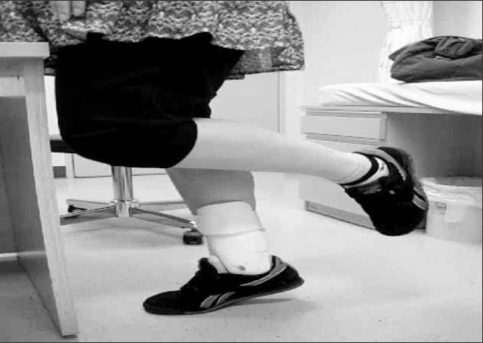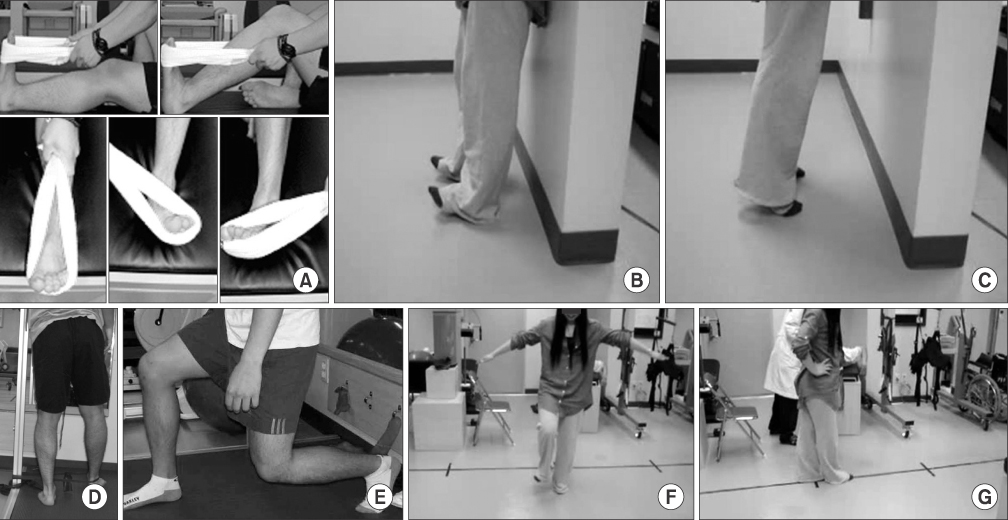J Korean Orthop Assoc.
2014 Feb;49(1):7-12. 10.4055/jkoa.2014.49.1.7.
Conservative Management of Ankle Sprains
- Affiliations
-
- 1Department of Orthopedic Surgery, Korea University Guro Hospital, Seoul, Korea. dakjul@korea.ac.kr
- KMID: 2185240
- DOI: http://doi.org/10.4055/jkoa.2014.49.1.7
Abstract
- Ankle sprains are the most common sports related lower extremity injuries. Lateral ankle sprains are most common in ankle sprains. The staged treatment is recommended for the acute lateral ankle sprain. First treatment for acute ankle sprains focuses on control of pain and swelling: protection, rest, ice, compression, and elevation (PRICE) is a well-established protocol for treatment of acute ankle injury. The second phase of treatment is allowed ankle range of motion (ROM) with stirrup brace and the third phase is the exercises which increase ROM and muscle strength around the ankle joint. Adequate treatment for acute lateral ankle sprain can prevent the occurrence of chronic lateral ankle instability. The chronic lateral ankle instabilities have two categories: function instability and anatomical instability. Functional exercise for improving proprioception and strength of peroneal muscle is the first line treatment for chronic lateral ankle instabilities instead of early surgery. Early functional exercises could improve the ankle function, protect the repeated ankle after acute lateral ankle sprain, and improve the symptoms of chronic lateral ankle instabilities.
Keyword
MeSH Terms
Figure
Cited by 3 articles
-
Residual Pain after Operative Treatment for Chronic Ankle Instability
Byung-Ki Cho, Byung-Hyun Ahn
J Korean Foot Ankle Soc. 2021;25(1):32-37. doi: 10.14193/jkfas.2021.25.1.32.Conservative Management and Postoperative Rehabilitation of Chronic Lateral Ankle Instability
Young Hwan Park, Hak Jun Kim
J Korean Foot Ankle Soc. 2019;23(1):6-11. doi: 10.14193/jkfas.2019.23.1.6.Evidence-based Treatment of Acute Lateral Ankle Sprain
Byung-Ki Cho
J Korean Foot Ankle Soc. 2018;22(4):135-144. doi: 10.14193/jkfas.2018.22.4.135.
Reference
-
1. Hockenbury RT, Sammarco GJ. Evaluation and treatment of ankle sprains: clinical recommendations for a positive outcome. Phys Sportsmed. 2001; 29:57–64.2. Baker JM, Ouzounian TJ. Complex ankle instability. Foot Ankle Clin. 2000; 5:887–896.3. Ferran NA, Maffulli N. Epidemiology of sprains of the lateral ankle ligament complex. Foot Ankle Clin. 2006; 11:659–662.4. Hubbard TJ. Ligament laxity following inversion injury with and without chronic ankle instability. Foot Ankle Int. 2008; 29:305–311.5. Hale SA, Hertel J, Olmsted-Kramer LC. The effect of a 4-week comprehensive rehabilitation program on postural control and lower extremity function in individuals with chronic ankle instability. J Orthop Sports Phys Ther. 2007; 37:303–311.6. Stiell IG, Greenberg GH, McKnight RD, Nair RC, McDowell I, Worthington JR. A study to develop clinical decision rules for the use of radiography in acute ankle injuries. Ann Emerg Med. 1992; 21:384–390.7. Clanton TO, Schon LC. Athletic injuries to the soft tissues of the foot and ankle. In : Coughlin MJ, Mann RA, editors. Surgery of the foot and ankle. St. Louis: Mosby;1999. p. 1114–1203.8. Kerkhoffs GM, Rowe BH, Assendelft WJ, Kelly KD, Struijs PA, van Dijk CN. Immobilisation for acute ankle sprain. A systematic review. Arch Orthop Trauma Surg. 2001; 121:462–471.9. Ivins D. Acute ankle sprain: an update. Am Fam Physician. 2006; 74:1714–1720.10. Bleakley CM, McDonough SM, MacAuley DC. Some conservative strategies are effective when added to controlled mobilisation with external support after acute ankle sprain: a systematic review. Aust J Physiother. 2008; 54:7–20.11. van Rijn RM, van Os AG, Bernsen RM, Luijsterburg PA, Koes BW, Bierma-Zeinstra SM. What is the clinical course of acute ankle sprains? A systematic literature review. Am J Med. 2008; 121:324–331.12. Kemler E, van de Port I, Backx F, van Dijk CN. A systematic review on the treatment of acute ankle sprain: brace versus other functional treatment types. Sports Med. 2011; 41:185–197.13. Tully MA, Bleakley CM, O'Connor SR, McDonough SM. Functional management of ankle sprains: what volume and intensity of walking is undertaken in the first week postinjury. Br J Sports Med. 2012; 46:877–882.14. Slatyer MA, Hensley MJ, Lopert R. A randomized controlled trial of piroxicam in the management of acute ankle sprain in Australian Regular Army recruits. The Kapooka Ankle Sprain Study. Am J Sports Med. 1997; 25:544–553.15. Petrella R, Ekman EF, Schuller R, Fort JG. Efficacy of celecoxib, a COX-2-specific inhibitor, and naproxen in the management of acute ankle sprain: results of a double-blind, randomized controlled trial. Clin J Sport Med. 2004; 14:225–231.16. Madden JW, Peacock EE Jr. Studies on the biology of collagen during wound healing. 3. Dynamic metabolism of scar collagen and remodeling of dermal wounds. Ann Surg. 1971; 174:511–520.17. Dizon JM, Reyes JJ. A systematic review on the effectiveness of external ankle supports in the prevention of inversion ankle sprains among elite and recreational players. J Sci Med Sport. 2010; 13:309–317.18. Lamb SE, Marsh JL, Hutton JL, Nakash R, Cooke MW. Collaborative Ankle Support Trial (CAST Group). Mechanical supports for acute, severe ankle sprain: a pragmatic, multicentre, randomised controlled trial. Lancet. 2009; 373:575–581.19. Dettori JR, Basmania CJ. Early ankle mobilization, Part II: a one-year follow-up of acute, lateral ankle sprains (a randomized clinical trial). Mil Med. 1994; 159:20–24.20. Kerkhoffs GM, Handoll HH, de Bie R, Rowe BH, Struijs PA. Surgical versus conservative treatment for acute injuries of the lateral ligament complex of the ankle in adults. Cochrane Database Syst Rev. 2007; (2):CD000380. Published online April 18, 2007; doi: 10.1002/14651858.CD000380.pub2.21. Pijnenburg AC, Bogaard K, Krips R, Marti RK, Bossuyt PM, van Dijk CN. Operative and functional treatment of rupture of the lateral ligament of the ankle. A randomised, prospective trial. J Bone Joint Surg Br. 2003; 85:525–530.22. Bernier JN, Perrin DH, Rijke A. Effect of unilateral functional instability of the ankle on postural sway and inversion and eversion strength. J Athl Train. 1997; 32:226–232.23. Tropp H, Odenrick P, Gillquist J. Stabilometry recordings in functional and mechanical instability of the ankle joint. Int J Sports Med. 1985; 6:180–182.24. Freeman MA. Instability of the foot after injuries to the lateral ligament of the ankle. J Bone Joint Surg Br. 1965; 47:669–677.25. Richie DH Jr. Functional instability of the ankle and the role of neuromuscular control: a comprehensive review. J Foot Ankle Surg. 2001; 40:240–251.26. DiGiovanni CW, Brodsky A. Current concepts: lateral ankle instability. Foot Ankle Int. 2006; 27:854–866.27. Patankar HP, Yeo ED, Kim SJ, et al. Novel balance tests for assessing functional ankle instability: relationships with BMI and gender. J Korean Foot Ankle Soc. 2012; 16:128–134.28. McKeon PO, Ingersoll CD, Kerrigan DC, Saliba E, Bennett BC, Hertel J. Balance training improves function and postural control in those with chronic ankle instability. Med Sci Sports Exerc. 2008; 40:1810–1819.29. Gribble PA, Hertel J. Effect of lower-extremity muscle fatigue on postural control. Arch Phys Med Rehabil. 2004; 85:589–592.30. Valovich McLeod TC. The effectiveness of balance training programs on reducing the incidence of ankle sprains in adolescent athletes. J Sport Rehabil. 2008; 17:316–323.31. DIGiovanni BF, Fraga CJ, Cohen BE, Shereff MJ. Associated injuries found in chronic lateral ankle instability. Foot Ankle Int. 2000; 21:809–815.32. van Dijk CN. Management of the sprained ankle. Br J Sports Med. 2002; 36:83–84.33. Löfvenberg R, Kärrholm J, Lund B. The outcome of nonoperated patients with chronic lateral instability of the ankle: a 20-year follow-up study. Foot Ankle Int. 1994; 15:165–169.34. Schmidt R, Benesch S, Friemert B, Herbst A, Claes L, Gerngross H. Anatomical repair of lateral ligaments in patients with chronic ankle instability. Knee Surg Sports Traumatol Arthrosc. 2005; 13:231–237.35. Youn H, Kim YS, Lee J, Choi WJ, Lee JW. Percutaneous lateral ligament reconstruction with allograft for chronic lateral ankle instability. Foot Ankle Int. 2012; 33:99–104.
Article36. Corte-Real NM, Moreira RM. Arthroscopic repair of chronic lateral ankle instability. Foot Ankle Int. 2009; 30:213–217.




